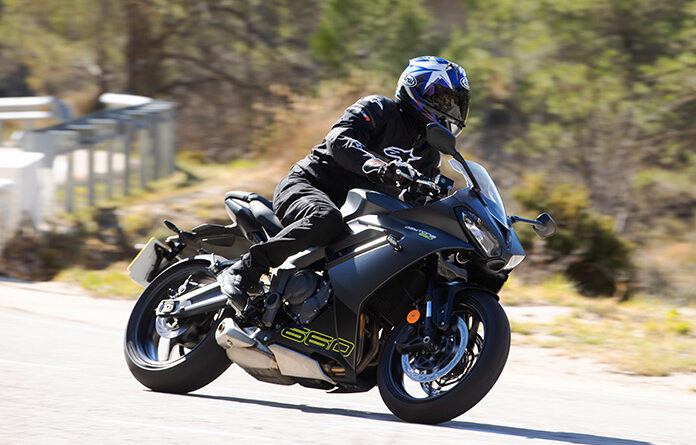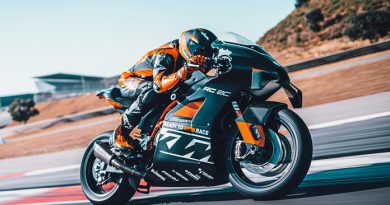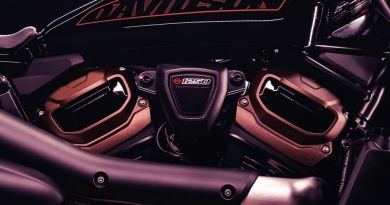2024 Triumph Daytona 660 Review | First Ride
In the mid-1990s, when I cut my teeth as a motorcyclist, the Big Four Japanese manufacturers were engaged in a middleweight sportbike arms race. Every other year, each brand unveiled an updated platform, squeezing a few more ponies out of their 599cc inline-Four engine and tweaking frame geometry, suspension systems, and brakes.
As a result of this one-upmanship, middleweight sportbikes went from entry-level all-arounders to racebikes with lights and license plates. Which is great, except for the fact that only a small percentage of riders spend weekends wearing down knee pucks at the track. Add to this that a tricked-out middleweight now costs nearly what a liter-class machine does, and we arrive at something of an evolutionary dead end.
And yet here we are with a new Triumph Daytona 660. The storied British manufacturer enters the highly competitive middleweight class by hitting the reset button, aiming to produce an affordable, attractive sportbike that can handle commuting and light touring, as well as footpeg-scraping backroads and the occasional trackday. To see if they pulled it off, Triumph invited us to Alicante, Spain, for a full day of riding in everything from city traffic to mountain passes.
Inline-Triple | Triumph Daytona 660
The Daytona 660 is powered by an updated version of the engine that powers Triumph’s Trident 660 and Tiger Sport 660, and it’s a callback to the Daytona 675 that Triumph produced from 2006-2018, which was the first inline-Triple in the middleweight sportbike class. The Triple provides the best of both worlds: torque in the lower rev ranges like a Twin and ample mid- and top-end power like a Four.
The Daytona 660’s 3-cylinder mill gets a trio of new 44mm throttle bodies and larger exhaust valves, and its airflow was increased with a front-mounted intake and a larger airbox. A new crankshaft with increased gear width provides smoother revving, the pistons now feature a low-friction coating, and the radiator and fan are both larger and have been repositioned for more efficient cooling. Exhaust gasses flow through a 3-into-1 header and into an underslung silencer that produces a satisfying growl that becomes a bark with a twist of the throttle.
These upgrades result in a claimed 95 hp at 11,250 rpm, a 17% increase over the Trident 660, and the Daytona’s 12,650-rpm redline is 20% higher than the Trident’s too. The engine cranks out 51 lb-ft of torque at 8,250 rpm (9% more than the Trident), with 80% of that power on tap at only 3,125 rpm. Triumph says the Daytona 660 will get you from 0-60 in just 3.6 seconds.
GEAR UP | Triumph Daytona 660
Helmet: Arai Corsair-X
Jacket: Alpinestars T-GP Plus R V3 Air
Airbag Vest: Alpinestars Tech-Air 5
Gloves: Alpinestars SP-8 v3 Air
Pants: Alpinestars Argon Tech
Boots: Fly Racing M21
Bespoke details | Triumph Daytona 660
At the tech briefing the night before our test ride, I got my first close look at the Daytona 660 in Satin Granite/Satin Jet Black, a color scheme that, combined with the “660” in neon green on the lower fairing, says “badass” without rubbing your nose in it. (Other colorways include Snowdonia White/Sapphire Black and Carnival Red/Sapphire Black.) The bike’s fit and finish make it look pricier than its $9,195 base price, and its styling is aggressive but exudes a bespoke elegance that stands out from its competition. Take a close look at how the fairing flows into the distinctive molding of the gas tank, or how the silencer nestles near the rear tire, and you’ll see that Triumph’s design team sweated the details. With minimal bodywork highlighting the powerplant and frame, the Daytona 660 looks impressive just leaning on its kickstand. I couldn’t wait to put some miles on it.
Capable commuter? | Triumph Daytona 660
We started our ride in morning traffic, threading through congested urban roundabouts – the first test of Triumph’s middleweight reset. Is the Daytona 660 a comfortable, capable, and intuitive commuter? It only took a few minutes on Spanish city streets to make me appreciate the availability of useful torque from low revs. Urban stop-and-go traffic is easier to navigate on a machine with a wide powerband, so you can squirt between vehicles without fiddling with the gearbox.
At low city speeds, even after shifting into a higher gear than necessary, the Daytona’s engine delivered smooth, confidence-inspiring power without the need to wind up to high rpm. The 6-speed gearbox, which has updated input/output shafts and revised gear ratios, is well-sorted. There are no annoying searches for neutral, each shift accompanied by a satisfying “snick,” and the slip/assist clutch feels light at the lever (Triumph offers an optional quickshifter for those who want to bypass the clutch).
The cockpit design is well-suited for city riding. The instrument panel, which is a hybrid LCD/TFT display, was easy to see through my tinted visor, even in bright light, and the tachometer, fuel gauge, gear indicator, and digital speedometer are clustered thoughtfully, giving me a lot of information with a quick glance down. The clip-on bars were easy on my wrists and didn’t force me to reach or crouch. Footpeg positioning was comfortable for my 6-foot frame. Likewise, the stock seat height of 31.9 inches was in the Goldilocks zone (Triumph offers a lower seat option that drops the saddle about an inch).
The Daytona 660’s engine, drivetrain, and ergonomics come together in an impressively intuitive commuter that I felt confident flinging around unfamiliar city streets on our way to the mountains to see if Triumph kept the “sport” in their new sportbike.
Into the mountains | Triumph Daytona 660
It was no accident that we were invited to ride the Daytona 660 through the mountains outside of Alicante. As we gained elevation, the beautifully engineered Spanish roads became downright exciting, with hairpins, sweepers, and significant elevation changes that put the bike’s chassis to the test. The radial 4-piston calipers, twin 310mm discs, and braided lines provided progressive, powerful braking without fading, even after miles of serpentine road.
Response from the throttle-by-wire throttle was precise and predictable. The three riding modes – Sport, Road, and Rain – each offer a different throttle response and level of traction control. Traction control can also be shut off, and a few of my fellow riders who did so had their rear tires step out on them under hard acceleration out of turns on dusty sections of road. I kept it engaged and didn’t have any such issues. In addition to traction control, the Daytona 660 is equipped with ABS, which adds to peace of mind when pushing the bike hard in the bends.
The Daytona 660’s steering geometry and stock Michelin Power 6 tires made it easy to flick through chicane-like mountain sections, and the Showa suspension – a nonadjustable 41mm inverted fork and a single rear shock with preload adjustability – kept things composed on hard braking into turns and over less-than-perfect bits of tarmac. The suspension package is not top-shelf, but it is up to the task for what most riders will ask the Daytona 660 to do: keep a big grin plastered on your face as you carve up your favorite backroads.
A great first impression | Triumph Daytona 660
The Daytona 660 won me over almost immediately. The folks at Triumph clearly spent a lot of time refining this machine, as it felt sorted out in a way that not all first-generation models do. And, as I spent more time on the bike and got a chance to uncork it on beautiful mountain roads, things just got better.
This is a powerful, agile, attractive motorcycle that ticks most of the important boxes for less than $10,000. Although our test ride kept me in the saddle for nearly eight hours, I was comfortable enough on the Daytona that I would readily sign up for touring duty, especially considering optional upgrades such as a tankbag and tailbag, heated grips, tire pressure monitoring, and the My Triumph Connectivity System that adds navigation as well as phone and music interactivity.
The Daytona 660 accomplishes what Triumph set out to do: reset the middleweight sportbike segment by offering a versatile, exciting motorcycle that is affordable enough for entry-level riders but capable enough for those with more experience and buying power. And, regardless of your moto skillset, this is a beautiful machine that outclasses the competition with design details usually reserved for pricier bikes. While this may not be the bike for riders who spend lots of time at their local track, that isn’t Triumph’s target audience. I hope Rider gets a Daytona 660 for a longer-term test, because the taste of this bike that I got in Spain left me wanting more.
Check out more new bikes in Rider’s 2024 Motorcycle Buyers Guide
2024 Triumph Daytona 660 Specs
Base Price: $9,195
Website: TriumphMotorcycles.com
Warranty: 2 yrs., unltd. miles
Engine Type: Liquid-cooled, transverse inline-Triple, DOHC w/ 4 valves per cyl.
Displacement: 660cc
Bore x Stroke: 74.0 x 51.1mm
Horsepower: 94 hp @ 11,250 rpm (factory claim)
Torque: 51 lb-ft @ 8,250 rpm (factory claim)
Transmission: 6-speed, cable-actuated slip/assist wet clutch
Final Drive: Chain
Wheelbase: 56.1 in.
Rake/Trail: 23.8 degrees/3.2 in.
Seat Height: 31.9 in.
Wet Weight: 443 lb (factory claim, 90% fuel)
Fuel Capacity: 3.7 gal.
Fuel Consumption: 57.6 mph (factory claim)
The post 2024 Triumph Daytona 660 Review | First Ride appeared first on Rider Magazine.




